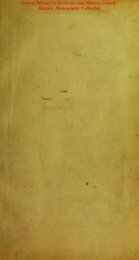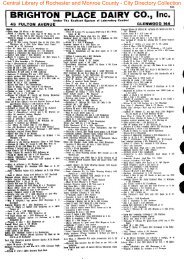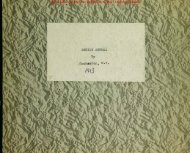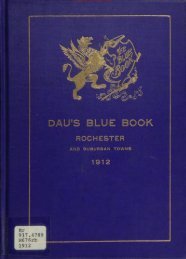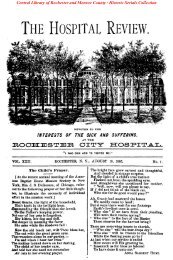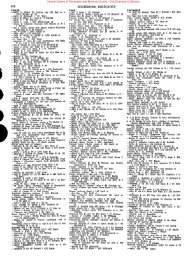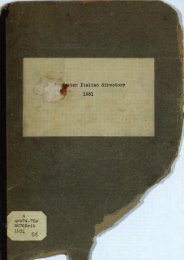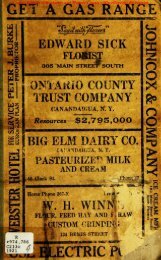The Farm Journal Illustrated Rural Directory of Monroe County, New ...
The Farm Journal Illustrated Rural Directory of Monroe County, New ...
The Farm Journal Illustrated Rural Directory of Monroe County, New ...
Create successful ePaper yourself
Turn your PDF publications into a flip-book with our unique Google optimized e-Paper software.
Central Library <strong>of</strong> Rochester and <strong>Monroe</strong> <strong>County</strong> · <strong>County</strong> Directories Collection<br />
MONBOE COUNTY<br />
Horse Ailments<br />
(From the Biggie Horse Book)<br />
<strong>The</strong> majority <strong>of</strong> horse ailments may<br />
be traced, directly or indirectly, to improper<br />
feeding and watering, careless<br />
management in the stable and in<br />
harness. A careless driver is a very<br />
frequent cause <strong>of</strong> loss.<br />
<strong>The</strong>re is no reason why a first-class<br />
team, six to eight years old, should not<br />
serve continuously and satisfactorily for<br />
a term <strong>of</strong> twelve to sixteen years, if<br />
properly protected, fed and looked out<br />
for.<br />
If, from improper care or feeding,<br />
or from some unavoidable cause, your<br />
horse is out <strong>of</strong> condition, # you should<br />
dose him with little medicine and much<br />
common sense.<br />
<strong>The</strong> horse that allows himself to be<br />
caught lying down may be considered<br />
out <strong>of</strong> condition or lacking sufficient<br />
nutritious food. A quart <strong>of</strong> linseed meal<br />
divided^ into three feeds and added to<br />
his grain dally will do him much good<br />
and help a quick shedding <strong>of</strong> the coat.<br />
BLINDNESS.—Consult a skilled veterinarian<br />
at once.<br />
BoTS.-—<strong>The</strong> bot-fly resembles a honeybee<br />
in size, and in late summer deposits<br />
eggs <strong>of</strong> a yellowish color on the hair<br />
<strong>of</strong> the horse's breast, legs, etc In trying<br />
to bite at these eggs, the animal<br />
gets some <strong>of</strong> them in his mouth and<br />
throat. <strong>The</strong> eggs soon hatch and the<br />
larvae attach themselves eventually to the<br />
lining <strong>of</strong> the stomach, and are then<br />
called "bots." <strong>The</strong>y remain in the stomach<br />
until the following spring. Of<br />
course, the presence <strong>of</strong> these pests<br />
causes more or less irritation, but, as a<br />
rule, no serious harm is done in ordinary<br />
instances. Contrary to popular belief,<br />
bots do not eat holes through a horse's<br />
stomach. We do not know <strong>of</strong> any treatment<br />
that will remove bots. Prevention<br />
should be the horse owner's main reliance<br />
Kill the flies whenever possible<br />
; hang pieces <strong>of</strong> red cloth from the<br />
halter throat-latch, so that the shaking<br />
<strong>of</strong> the head when a horse is in pasture<br />
may serve to frighten the flies away;<br />
and scrape <strong>of</strong>f, from time to time, any<br />
eggs which are found on the horse.<br />
BROKEN-WIND.—See Heaves.<br />
CAPPED HOCK.—May be reduced in the<br />
same manner as Wind Galls (which see).<br />
CHOKING.—Horses that choke thrust<br />
out their heads, bend and stretch the<br />
neck, while there is a copious flow <strong>of</strong><br />
saliva from the mouth. In some cases<br />
there is distention <strong>of</strong> the gullet on the<br />
left side <strong>of</strong> the neck, if it has descended<br />
so far. If. it be in the upper part <strong>of</strong><br />
the gullet a man accustomed to giving<br />
balls may be able to reach it with his<br />
hand. Obstructions that have got lower<br />
down may be moved upward gently from<br />
the outside. Sometimes an obstruction<br />
is s<strong>of</strong>t and may be crushed small enough<br />
for the animal to swallow it. A mass<br />
<strong>of</strong> meal or other impacted food is sometimes<br />
removed by frequent drinks , <strong>of</strong><br />
water, and a drench <strong>of</strong> olive or cotton<br />
seed oil can do no harm. <strong>The</strong> plan <strong>of</strong><br />
reaching a Whip or heavy piece <strong>of</strong> rope<br />
down the gullet to push the substance<br />
into the stomach is risky, in the hands<br />
<strong>of</strong> one not accustomed to the anatomy<br />
<strong>of</strong> the horse.<br />
CHOKING DISTEMPER. — This disease<br />
prevails at times in many parts <strong>of</strong> the<br />
country. It is sometimes called spinal<br />
meningitis or putrid sore throat. <strong>The</strong><br />
animal <strong>of</strong>ten falls down paralyzed, - cannot<br />
arise, and if left prostrate is almost<br />
sure to die. He must be got upon his<br />
feet, and if he cannot stand must be<br />
swung. A majority <strong>of</strong> cases are fatal.<br />
It is caused by some specific poison<br />
taken into the system with food or<br />
drink, mostly the former. Dirty mangers,<br />
rotting roots "or meal, and mouldy<br />
hay, especially meadow hay, are usually<br />
the media by which the disease is ac-<br />
-quired. <strong>The</strong> moral is to have everything<br />
sweet and clean that the animal<br />
eats and drinks, and have no decayed<br />
matter in the entry or in, any other part<br />
<strong>of</strong> the barn. (See Distemper.)<br />
COCKED ANKLE.—See Knuckling.<br />
COFFIN-JOINT LAMENESS. — Same as<br />
Navicular Disease (which see).<br />
COLIC, SPASMODIC.—This begins suddenly.<br />
<strong>The</strong> horse stamps impatiently,<br />
looks backward, soon paws, and then<br />
rolls. After an interval <strong>of</strong> ease the<br />
pains return with increased severity.<br />
Give chloral hydrate, one ounce, in half<br />
a pint <strong>of</strong> water as a drench; or ether<br />
and laudanum, two ounces each, in lin-,<br />
seed oil, half a pint; or sulphuric ether<br />
and alcohol, two ounces <strong>of</strong> each in eight<br />
ounces <strong>of</strong> water. If nothing else is<br />
handy, give <strong>of</strong> whiskey half a pint in<br />
hot water. If not relieved in one hour<br />
repeat any <strong>of</strong> the doses prescribed. <strong>The</strong><br />
body should be warmly clothed and<br />
sweating encouraged. Dip blankets m.<br />
hot water containing a small quantity<br />
388



